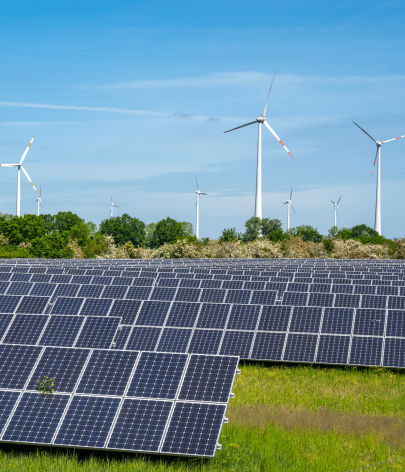Highlights
-5%
EU power demand fell by 5% year on year in the first half of 2023
-17%
EU fossil fuel generation fell by nearly a fifth in the first half of 2023
17
Seventeen EU countries had record renewable generation from January to June
About
This report analyses changes in Europe’s power sector from January to June 2023 to measure the progress of its clean energy transition.
Executive summary
Drop in demand drives EU fossil fuels to collapse
Solar leads the EU’s clean energy transition as coal and gas slump
Europe data analyst, Ember
The decline in fossil fuels is a sign of the times. Coal and gas are too expensive, too risky, and the EU is cutting them out. But we need to see clean power replacing fossil fuels faster. A massive push, especially on solar and wind, is urgently needed to underpin a resilient economy across Europe.

The fossil fall
EU fossil generation hits a record low in the first half of 2023
Drop in demand drives EU fossil fuels to collapse. Wind and solar continue growing while hydro and nuclear recover from historic lows.
In this chapter:
The first half of 2023 showed some encouraging signs for the energy transition. Fossil fuel generation fell substantially, wind and solar power continued to rise, and other clean sources recovered from underperformance last year. However, much of the fossil decline can be attributed to a significant fall in electricity demand, much of which is not sustainable or desirable. While trends of falling coal and gas generation must continue in order to achieve EU and country level targets on decarbonisation, Europe cannot rely on undesirable demand reduction to achieve this.
The need to address this dynamic is even more pressing with the push to electrify across sectors. With wider electrification, electricity demand will ultimately rise. European policy makers must ensure that the conditions are right for this increase to be met by clean sources rather than fossil fuels. Not only does this require the acceleration of wind and solar deployment, but also the urgent development of key enablers to support renewables such as streamlined permitting, grid expansion and adequate storage deployment. It is essential that a coordinated whole system approach is placed at the top of the political agenda across Europe, to unlock the security and cost benefits of clean power.
Supporting Material
Methodology
The data in this piece is curated by Ember. The full dataset is available to download. Please address any data queries to [email protected].
Monthly generation, imports and demand
Monthly data is gathered from a number of sources, including both centrally reported ENTSO-E data and directly reported national transmission system operators. In some cases data is published on a monthly lag; here we have estimated recent months based on relative changes in previous years. These cases are flagged in the dataset.
Monthly published data is often reported provisionally, and is far from perfect. Every effort has been made to ensure accuracy, and where possible we compare multiple sources to confirm their agreement.
Countries included and sources for recent monthly data
A complete country-by-country methodology for all countries, including those outside of Europe, is available for download here.
- Austria: ENTSO-E
- Belgium: ENTSO-E
- Bulgaria: ENTSO-E
- Croatia: ENTSO-E
- Cyprus: Eurostat, with demand estimates from the Cyprus Transmission System Operator
- Czechia: ENTSO-E
- Denmark: ENTSO-E
- Estonia: ENTSO-E
- Finland: Biomass, gas, hydro, solar and wind from Eurostat; other fuels from ENTSO-E
- France: ENTSO-E
- Germany: Agora
- Greece: ENTSO-E
- Hungary: Solar data from 2020 from Eurostat; other fuels from ENTSO-E
- Ireland: Sustainable Energy Authority of Ireland
- Italy: Biomass and behind-the-meter solar from Terna; other fuels from ENTSO-E. Flow data from Terna
- Latvia: ENTSO-E
- Lithuania: ENTSO-E
- Luxembourg: Eurostat
- Malta: Eurostat
- Netherlands: Statistics Netherlands, with recent months estimated using data from ENTSO-E and NetAnders. We are grateful to NetAnders for the use of their data
- Poland: Historical solar data from ARE via Instrat; other fuels from ENTSO-E
- Portugal: ENTSO-E
- Romania: ENTSO-E
- Slovakia: ENTSO-E
- Slovenia: ENTSO-E
- Spain: ENTSO-E. Flow data from REE
- Sweden: ENTSO-E
Hourly coal generation
Hourly generation data for the Netherlands and Greece is taken from ENTSO-E. In the case of the Netherlands coal was very slightly above 0 MW on several occasions due to occasional very small injections from the outed Maasvlakte 3. We have taken this to be functionally no generation.
Distributed solar
In recent years the EU has deployed a large amount of solar generation not metered on the transmission network, in large part on rooftops. Because this generation is rarely measured directly it must be estimated. In several countries, such as Italy, Belgium, Poland and France, the national TSOs report such estimates, while in the Netherlands estimates are made after the fact by Statistics Netherlands and in real time by NetAnders. Elsewhere however, in at least eleven countries including Spain, Hungary, Bulgaria, Romania, Portugal and Austria, estimates are not reported. Instead, unmeasured solar is visible to some extent as “missing” demand: reported demand being lower than expected during peak solar hours, as a result of the grid needing to serve less load due to households consuming their own solar power. At high levels this results in a visible duck curve.
Reservoir levels
Reservoir levels are from RTE and Nordpool, with Montel providing figures for Switzerland and Austria. ENTSO-E water reservoir filling rates were also checked to confirm conditions.
French nuclear availability
French nuclear availability is reported by Montel, and can be calculated from outage reports published on ENTSO-E.
Historical demand
Demand before 2015 is calculated from Eurostat historical monthly generation data, counting all current EU-27 Member States (so including Croatia and excluding the UK for all periods). Data was checked against Ember monthly data to ensure comparability.
Gas imports
Gas import data is provided by Bruegel.
Acknowledgements
We are grateful to NetAnders for the use of their data in the Netherlands. Thanks to Ali Candlin, Sarah Brown, Reynaldo Dizon, Uni Lee and Chris Rosslowe for their contributions and review.
Image creditD.C IMAGES / Alamy Stock Photo





